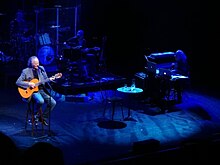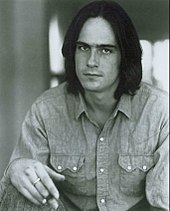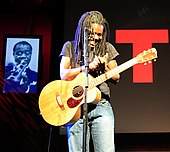Singer-songwriter
A singer-songwriter is a musician, usually a soloist, who writes, composes, and sings his own songs. Although there are many singers of various genres who write their own songs, the term singer-songwriter is often used to refer mainly to folk-acoustic artists in which the message prevails over the music, with songs that often incorporate social, political, personal themes. or philosophical.
The characteristic musical genre of the singer-songwriter is known as songwriter. For a while, this type of music was called a protest song. Today the genre is less loaded with critical or vindictive connotations than in the past, giving space to individual and philosophical reflections, and even dealing with issues related to romantic love.
Definition and usage
The tag "singer-songwriter" (or "songwriter/singer") is used by record labels and critics to define popular music artists who write and perform their own material, which is often self-accompanied -usually on guitar or piano-. Such an artist fills the roles of composer, lyricist, vocalist, sometimes instrumentalist, and often self-manager. According to AllMusic, singer-songwriters' lyrics are often personal but veiled in elaborate metaphors and vague imagery, and their concern creative is putting the emphasis on the song rather than your performance. Most of these artists' records have a similarly direct and spare sound that puts the emphasis on the song itself.
The term can also characterize composers of the rock, folk, country, and pop-music genres - including Henry Russell (1812-1900), Aristide Bruant (1851-1925), Hank Williams (1923-1953), and Buddy Holly (1936-1959). The expression "singer-songwriter", registered from 1949, came into popular use from the 1960s to describe composers who followed certain stylistic and thematic conventions, particularly lyrical introspection, confessional songwriting, soft musical arrangements, and an understated performance style. According to writer Larry David Smith, by conflating the composer roles, writer and singer, the popularity of the singer-songwriter phenomenon reintroduced the medieval troubadour tradition of "songs with a public personality" following the Tin Pan Alley era in American popular music. Themes in songs by American folk music revival singer-songwriters included political protest, such as Woody Guthrie (1912-1967) and Pete Seeger (1919-2014). According to the Journal of Popular Music Studies, from the folk revival to his tenure in pop music, the role of a singer-songwriter has involved several dimensions of creative identity:
The first aesthetic layer encourages singers to sing and interpret their own works and to infuse their own stylistic flavors in the texts of the songs. The composers are not independent of the works once finished, but they enter the texts of the songs, activate them and authenticate them through their vocal and musical interpretations. While the first stratum does not always require the singer to be the composer, the second sociological stratum is not only fixed on the relationship between the singer and the composer (in this case, the term singer-compositor often splits with a script rather than using a bar between the singer and the composer), but also requests more sociological agency apart from the song and composition, such as the arrangements, the mix, the production, the collaboration and the management of the media. In other words, a singer submits to a process of thickening that involves two voices, including the interpretation of the stylistic person, the accumulation of other voices and the coordination of other sociological skills. This process of thickening demonstrates the fluid, multiple and heterogeneous voices that are below the singular authoral image, thus complicating the notion of authorship of the singers.
Origins and development in the Spanish-speaking world
The author's song has a great tradition in the countries of Mediterranean culture in southern Europe and in most of Latin America. It is a genre that, above all, claims a personal and critical view of the author on the world that surrounds him and that is accompanied, in general, by his own poetics.
This type of music had its golden age in the 1970s and 1980s (linked to the social movements that were developing at that time). In Hispanic countries, it received the name of the new song, both in Spain (with artists such as Chicho Sánchez Ferlosio, Paco Ibáñez, Joan Manuel Serrat, Luis Eduardo Aute, Javier Krahe, Lluís Llach, Víctor Manuel, Patxi Andión, Joaquín Sabina or Cecilia) as in Latin America (Violeta Parra, Víctor Jara, Silvio Rodríguez, Alfredo Zitarrosa, Víctor Heredia, León Gieco, Pablo Milanés or Atahualpa Yupanqui).
In the 1980s this genre began to be represented by figures associated with rock in Spanish such as: Charly García, Luis Alberto Spinetta, Fito Páez, Andrés Calamaro, Joaquín Sabina, Franco de Vita and Miguel Matthews; In the Hispanic American genres, the most outstanding figures were: Rubén Blades and Juan Luis Guerra.
During the 1990s, it reemerged with a new batch of young authors who revolutionized traditional auteur music. They had little more in common than the fact that they were authors of their own compositions. The most important of this generation are Ricardo Arjona, Alejandro Sanz, Ricardo Montaner, Soraya, Juanes and Shakira. Other prominent romantic singer-songwriters include: Armando Manzanero, Roberto Carlos, José Luis Perales and Juan Gabriel.
In the genre of flamenco, the artists José Menese, Enrique Morente, El Cabrero and El Barrio have included protest songs within the cante.
Development in other countries
The movement in the United States was also important: (Woody Guthrie, Pete Seeger, Bob Dylan, Joan Báez), France (Georges Brassens, Charles Trénet, Léo Ferré, Charles Aznavour, Marcel Amont, Jean Ferrat), Italy (Fabrizio De André, Giorgo Gabber, Domenico Modugno, Francesco de Gregori, Claudio Baglioni, Franco Battiato) and in Eastern European countries.
Traditions in North America, United Kingdom and Ireland
The term "singer-songwriter" in North America it goes back to singers who developed works in the style of blues and folk music. American singer-songwriters of the early and mid-20th century include Lead Belly, Jimmie Rodgers, Blind Lemon Jefferson, T-Bone Walker, Blind Willie McTell, Lightnin' Hopkins, Son House, and Robert Johnson. In the 1940s and 1950s country singer-songwriters such as Hank Williams became well known, as well as Woody Guthrie, and Pete Seeger, along with Ronnie Gilbert and Lee Hays and other members of the Weavers who performed his works, mostly topical, to an ever-widening audience. These proto-songwriters were less concerned than today's singer-songwriters with the unadulterated originality of their music and lyrics, picking up parts of other songs and playing covers without hesitation. This group of musicians established the tradition of writing topical songs (songs related to specific issues of the time, such as Lead Belly's "Jim Crow Blues" or "Deportado (Plane Wreck at Los Gatos)& #34; of Guthrie). Singers like Seeger and Guthrie attended union rallies, so they wrote many songs related to working-class life and social protest; as did other folk singers like Josh White, Cisco Houston, Malvina Reynolds, Earl Robinson, Ewan MacColl, John Jacob Niles and Doc Watson, while blues singers like Johnson and Hopkins wrote songs about their personal life experiences. This focus on social issues has greatly influenced the genre of singer-songwriters. In addition, between the 1930s and 1950s, various jazz and blues singer-songwriters emerged such as Hoagy Carmichael, Billie Holiday, Ray Charles, Harry Gibson, Peggy Lee and Nina Simone, as well as in the rock n' genre. roll from which emerged the influential singer-songwriters Jerry Lee Lewis, Buddy Holly, Chuck Berry, Roy Orbison, Sam Cooke, Ritchie Valens and Paul Anka. In the realm of country music, singer-songwriters such as Hank Williams, Patsy Cline, Tammy Wynette, Loretta Lynn, George Jones, Merle Haggard, Roger Miller, Billy Edd Wheeler, and others emerged from the 1940s to the 1960s through often writing compelling songs about love relationships and other topics.
The singer-songwriter's first popular recognition in English-speaking North America and the United Kingdom came in the 1960s and early 1970s, when a number of blues, folk, and country musicians rose to fame and fame. popularity. These singer-songwriters include Bob Dylan, Neil Young, John Lennon, Van Morrison, Willie Nelson, Paul Simon, Leonard Cohen, and Joni Mitchell. Artists who had been primarily songwriters, such as Carole King, Townes Van Zandt, and Neil Diamond, also began to publish work as performers. In contrast to the narrative approach of most earlier country and folk music, these performers often wrote songs from a highly personal (often first-person) and introspective point of view. The adjectives "confessional" and "sensitive" were often used (sometimes derisively) to describe the style of singer-songwriters.
In the days of rock bands, members weren't technically solo singer-songwriters. However, many were singer-songwriters creating songs with other band members. Some examples are Paul McCartney, John Lennon, George Harrison, Ringo Starr, Brian Wilson, Mick Jagger, Keith Richards, Jerry Garcia and Bob Weir, Elton John (with Bernie Taupin), Justin Hayward, John Lodge, Robbie Robertson, Ian Anderson, Phil Collins, Peter Gabriel and Peter Frampton; Don Henley, Glenn Frey, Country Joe McDonald, Barry Melton. Many others like Eric Clapton found success as singer-songwriters in their later careers.
The scene that had developed out of the American folk music revival, pioneered by Woody Guthrie and Pete Seeger, had grown into a major movement by the early 1960s, popularized by Joan Baez and her protégé, Bob Dylan, who had begun to reach a mainstream audience with his hit, Blowin' in the Wind" (1963) bringing "protest songs" to a broader audience. There were hints of cross-pollination, but rock and folk music had largely remained separate genres, often with different audiences. An early attempt to fuse elements of folk and rock was evident in the Animals' song "House of the Rising Sun" (1964), a folk song, recorded with rock and roll instrumentation.
In the mid-1960s, Bob Dylan led the way in fusion of folk and rock and, in July 1965, released "Like a Rolling Stone," with a revolutionary rock sound, steeped in tacky urban imagery, followed by an electric performance later that month at the Newport Folk Festival. Dylan introduced an entire generation to the singer-songwriter's milieu. Dylan, who often wrote from an urban point of view, with poetry marked by rock rhythms and electric power, freed up-and-coming singer-songwriters to use elements of both traditions to tell their stories. In the mid-to-late 1960s, bands and singer-songwriters began to proliferate in New York's underground music and art scene. The launch of The Velvet Underground & Nico in 1967, featuring singer-songwriter Lou Reed and German singer-collaborator Nico was described as the "most prescient rock album ever made" by Rolling Stone in 2003.
In the late '60s, a new wave of female singer-songwriters broke through the confines of pop, using the urban landscape as a canvas for lyrics in the confessional style of poets like Anne Sexton and Sylvia Plath. These trailblazing women were featured in a July 1969 Newsweek article, 'The Girls: Letting Go: 'What's in Common - Joni Mitchell and Lotti Golden, Laura Nyro, Melanie, and Elyse Weinberg, are the personalized songs they write, like journeys of self-discovery, brimming with keen observation and surprising in the impact of their poetry. " In The Guardian, author Laura Barton describes the sea change in subject matter: they sang about politics, love affairs, the urban landscape, drugs, disappointment, and the life and loneliness of the traveling performer. Lotti Golden, on her debut Atlantic album Motor-Cycle, chronicled her life in New York's East Village in the late 1960s counterculture, visiting themes like gender identity (The Space Queens-Silky is Sad) and excessive drug use (Gonna Fay's). The women in the 1969 Newsweek article ushered in a new era of contemporary female singer-songwriters that has informed generations of female singer-songwriters into the 21st century, featuring poet Warsan Shire as the muse for Beyoncé's 2016 album Lemonade.
By the mid-'70s and early '80s, the original wave of singer-songwriters had been largely absorbed into a more general pop or soft rock format, but some new artists in the singer-songwriter tradition (including Billy Joel, Stevie Wonder, Bruce Springsteen, Tom Petty, Jackson Browne Chris Isaak, Victoria Williams, John Mellencamp and Warren Zevon) continued to emerge, and in other cases rock and even punk rock artists such as Peter Case, Paul Collins and Paul Westerberg made the transition to careers as solo singer-songwriters. Kate Bush remained distinctive throughout with her idiosyncratic style.
In the late 1980s, the term was applied to a group of predominantly female American artists, beginning with Suzanne Vega, whose first album sold unexpectedly well, followed by the likes of Tracy Chapman, Melissa Etheridge, Nanci Griffith, K. d. lang, Shania Twain, Sarah McLachlan, Shawn Colvin, Sheryl Crow, Lisa Loeb, Joan Osborne, Indigo Girls and Tori Amos, which was successful first in the UK and then in its home market. In the early 1990s, female artists with new styles also began to emerge, such as Courtney Love and PJ Harvey. Later, in the mid-1990s, the term resurfaced again with the success of Canadian Alanis Morissette and her breakout album Jagged Little Pill.
Also in the 1980s and 1990s, artists such as Bono, The Edge, Dave Matthews, Jeff Buckley, Richard Barone, Duncan Sheik, and Elliott Smith borrowed from the tradition of singer-songwriters to create new styles of acoustic-based rock. In the 2000s, a quieter style emerged, with largely impressionistic lyrics, by the likes of Norah Jones, Conor Oberst, Sufjan Stevens, David Bazan, South San Gabriel, Iron & Wine, David Gray, Ray LaMontagne, Meg Hutchinson, Darden Smith, Josh Rouse, Steve Millar, Jolie Holland, Patrick Duff, Richard Buckner, Jewel, Jack Savoretti, Richard Shindell, John Gorka, and Antje Duvekot. Some began to branch out into new genres like Kurt Cobain, Noel Gallagher, T Bone Burnett, Eddie Vedder, and Pete Yorn. Others used the drug as a form of mind-altering to boost creativity; for example, Emil Amos of Holy Sons took drugs daily from the age of sixteen, wrote over 1,000 songs, and landed a record deal with an indie label.
Recording on professional-grade systems became affordable to individuals in the late 1990s. This created opportunities for people to record and sell their music independently. These artists are known as "indies" because they publish their records on independent record labels, often their own, or without any label at all. Additionally, the Internet has provided a means for indies to get their music out to a wider audience.
| . | . |
Contenido relacionado
Mudejar
362
Visual arts










